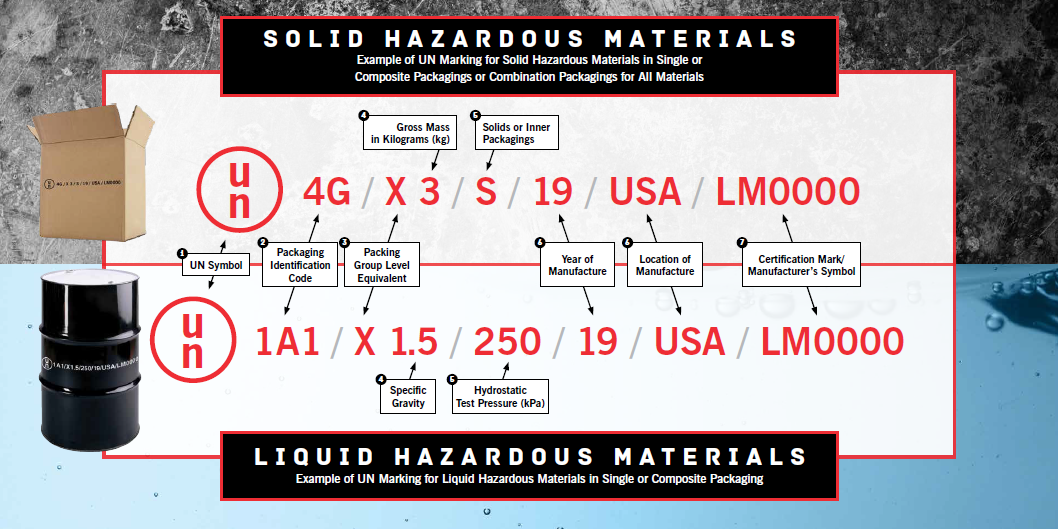







UN Mark certificate
The UN mark is a global system established by the United Nations for the classification, packaging, labeling, and marking of hazardous materials to ensure their safe transportation by road, rail, sea, and air. Testing must be conducted before a UN certification mark is granted, and the packaging must meet or surpass minimum performance standards before it can be used.
The UN Mark was first introduced as part of the United Nations Recommendations on the Transport of Dangerous Goods, also known as the Orange Book. These recommendations were developed by the United Nations Committee of Experts on the Transport of Dangerous Goods in the late 1950s and early 1960s, in response to the need for global standardization in the safe transport of hazardous materials.
The first UN Mark would have been issued after the implementation of these guidelines, as national and international regulatory bodies adopted the recommendations. National authorities or accredited third-party bodies, authorized by governments, began certifying packaging for compliance with UN standards. This system created a globally recognized method to ensure safety during the transport of dangerous goods by sea, air, road, and rail.
The specific date or entity that issued the very first UN Mark is not widely recorded, as the system was gradually adopted across different countries. However, the process of certification follows the framework set by the UN, which delegates authority to national bodies for certification and testing.
United Nations Symbol
Elements of Un Markings - Un Packaging Codes
UN Symbol
Packaging Identification Codes
Packaging Group Level Equivalent
Gross Mass or Specific Gravity
Hydrostatic Test Pressure or Solids
Year and Location of Manufacturer
Identification of the Manufacturer or Approval Agency
The UN in the circle indicates packaging has been UN tested and certified. The UN symbol can either be included with a lowercase "u" over a lowercase "n" in a circle or as an uppercase "UN".

Nine classes of Dangerous Goods
Class 1: Explosives (gunpowder, firework)
Class 2: Gases (carbon monoxide, propane)
Class 3: Flammable liquids (petrol, paint)
Class 4: Flammable solids (sulphur, magnesium powder)
Class 5: Oxidising substances & organic peroxide (sodium nitrate, zinc peroxide)
Class 6: Toxic & infectious substances (barium cyanide, arsenic)
Class 7: Radioactive material (uranium hexafluoride)
Class 8: Corrosive substances (potassium hydroxide)
Class 9: Miscellaneous dangerous substances & articles
(plastic moulding compound, medical kit)
Some types of Packaging
1 — Drums/Pails
2 — Barrels
3 — Jerricans
4 — Box
5 — Bag
6 — Composite packaging
13 — IBC, Flexible type for solid
31 — IBC, Rigid type for liquid
Material of Construction
A — Steel
B — Aluminum
C — Natural wood
D — Plywood
F — Reconstituted wood
G — Fiberboard
H — Plastic material
L — Textile
M — Paper, multi-wall
N — Metal (other than steel or aluminum)
P — Glass, porcelain or stoneware (not used in these regulations)
Container Packaging Head or Material Wall Type
For Drums:
1 - Closed Head (Non-Removable Head)
2 - Open Head (Removable Head)
For Bags:
5M1 - Multiwall
5M2 - Multiwalled, Water-Resistant
The following styles represent examples of UN packaging identification codes:
1. A number-letter combination may indicate the packaging type and the construction material. For example:
- 4D = Plywood Crate
- 2D = Plywood Wooden Barrel
2. A number-letter combination may also represent the packaging type, material of construction, and a subcategory or variation within the packaging type. For example:
- 1A1 = Non-Removable Head Steel Drum
- 4GV = Fiberboard Box Variation II Packaging
3. Some codes may use a number-letter-letter-number format. In this case, the number "6" signifies a composite packaging type, followed by two letters—one for the material of the inner receptacle and the other for the outer material. The final number indicates the packaging type, not a subcategory. For example:
- 6HA1 = Composite Packaging with a Plastic Inner, Steel Outer, Drum
- 6DC4 = Composite Packaging with a Natural Wood Inner, Plywood Outer, Box
Packaging Group Level Equivalent

The letters X, Y, or Z indicate the packing group level the package has been tested for:
- X = Packing Group I (Highest Danger)
- Y = Packing Group II (Moderate Danger)
- Z = Packing Group III (Lowest Danger)
According to regulations, packaging tested for the highest hazard level can also be used for materials with lower hazards. Therefore, the following usage is allowed:
- X = Packing Group I, II, III
- Y = Packing Group II, III
- Z = Packing Group III
Ensure Packaging Integrity for Hazardous Goods
An increasing number of countries now require that hazardous imported goods be securely packaged to endure the rigors of shipping and transport. Nations like the United States, European countries, Canada, Japan, and Australia mandate that such imports comply with the safety standards set by the United Nations Recommendations on the Transport of Dangerous Goods.
With over 29 years of experience in the field of obtaining standard certificates and membership in international professional associations, Sohatoos proudly announces its readiness to carry out all the procedures of issuing and obtaining the UN Mark Certificate for the esteemed applicants.
Updated on: Thursday, September 26, 2024